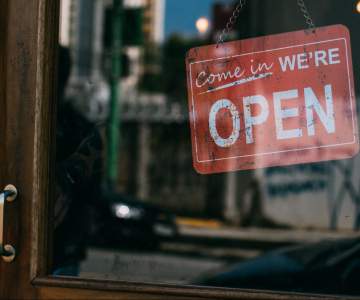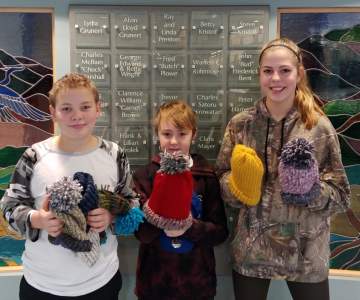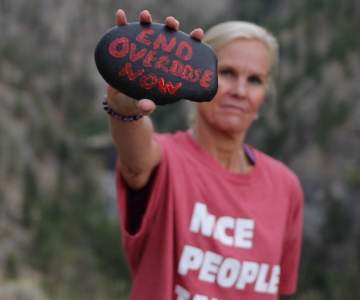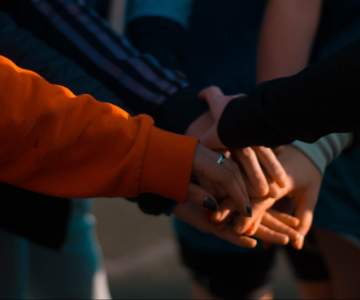Breadcrumb
Explore Stories
2 Minute Read
Community & Culture
Dealing with a severe speech disorder and transitioning from hospital to home was more than enough for the Freeborn family to cope with. Adding COVID-19 to the mix and hospital visitor restrictions, and problems could have easily gone from bad to worse.
Despite those challenges, this family was able to find a way around those obstacles, with the help of Kelly Talbott, a speech language pathologist at Kelowna General Hospital (KGH).
Larry Freeborn was in hospital dealing with Wernicke’s aphasia, a disorder which makes it difficult for him to understand the meaning of spoken words and sentences. This condition also makes it a struggle for him to use words to express himself in a meaningful way.
Earlier this month, Larry was finally well enough to go home. Prior to leaving KGH, Larry and his family needed help figuring out how to communicate with each other. But with physical distancing regulations at the hospital, the ideal process of face-to-face education in the same room was not an option.
So Kelly devised a work-around to help this family get the support they needed at a critical time in their lives. In the days leading up to Larry’s transition home, Kelly joined his family from a safe distance on their daily visits with Larry though a hospital window.
Through the window, she demonstrated the techniques this family would need to be successful communicating with each other.
Although life inside and outside the hospital is not what it used to be, creativity and a people-focused approach made a big impact in the lives of this family.
2 Minute Read
Health & Wellness
Is there an older adult in your life? Staying connected despite social distancing can be a real challenge.
2 Minute Read
Health & Wellness
More than four years ago B.C. declared a public health emergency in the face of unprecedented overdose deaths.
Since that time, more than 789 lives have been lost within the Interior Health community.
Important progress has been made and the evidence is promising. Research from the BC Centre for Disease Control shows that harm reduction efforts are saving lives.
"While the number of overdose deaths declined from 2018 to 2019, there are still countless families reeling from the unfathomable grief of losing a loved one. Now, we are facing a global pandemic on top of a fentanyl-poisoning crisis." -- Judy Darcy, Minister of Mental Health and Addictions
Some of the ways we've been working to reduce overdose deaths in our communities are:
Introducing overdose prevention services and mobile supervised consumption servicesImproving our ability to track overdosesParticipating in the B.C. Take Home Naloxone programEnhancing access to opioid agonist treatmentsExpanding mental health and substance use services, such as increased outreach and follow-up efforts Last year the Burning Bright candle display commemorated the anniversary of the overdose crisis and marked the number of lives lost to overdose.
“In this unprecedented time of two public health emergencies, we must work together to both flatten the curve and stop overdose deaths. We cannot afford to stop caring about one health-care crisis as we stare down another. -- Judy Darcy, Minister of Mental Health and Addictions
Interested in learning more? Read the Minister’s statement about the ongoing overdose crisis and the challenges of having two health emergencies.
2 Minute Read
Health & Wellness
Penticton resident George Garland has a deep and personal connection to health care in the South Okanagan. His beloved wife Marie spent quite a bit of time at Penticton Regional Hospital while receiving care for Parkinson’s disease and her other health issues.
In memory of Marie, George has donated $100,000 for medical equipment at Penticton Regional Hospital.
George says he was smitten with his future wife Marie almost from the moment he met her at an Edmonton diner more than 66 years ago. In the early 1950s he was working as a heavy equipment operator in Edmonton and often had dinner at the same café where Marie worked as a waitress.
”I used to eat there nearly every night,” George says. “Our first date went well and we hit it off.”
The couple moved to Penticton in 1991.
Several years later, Marie’s health started to decline. “She spent quite a bit of time in the hospital. At one point the doctor took me to the chapel and said he didn’t think she would make it, but she pulled through,” says George.
In her later years, Marie also suffered from Alzheimer’s. She passed away at a care centre in Summerland in September 2018.
George’s donation to the South Okanagan Similkameen Medical Foundation will go a long way towards helping patients at Penticton Regional Hospital. Construction is already well underway on the second phase of the hospital expansion, including a major upgrade to the Emergency Department scheduled for completion by the fall of 2021.
Marie and George
3 Minute Read
Community & Culture
A cove is considered a safe harbour in a storm.
“Bro’s Cove” in Cranbrook is no different.
The men’s consignment store opened in September 2018 and is run by the Kootenay Initiative Program (KIP), one of Interior Health’s Community Mental Health Programs. It offers support and training for men with mental illness.
“It isn’t just a job for me. It’s a safe environment, where I feel better,” says Brandon. “It gives me a sense of accomplishment that everyone needs. I feel like this is a really good place. All the help they give me – it’s a God send.”
Brandon is one of eight staff members who work in the store. Many of them were part of the initial planning and have been involved in developing the store from the ground up, taking business courses and building a business plan, marketing, gathering donations and designing the store, right down to picking the name and the surfside décor theme. In planning for the store, the green aspect of recycling clothing was appealing to the group. And as an added bonus – there are great deals to be had.
“These fellows all have a chronic and persistent mental illness like schizophrenia or bipolar disorder. Many have struggled to be accepted their whole life, and here they can be exactly who they are. We will work with them to help them become the best they can be by becoming involved in a work program. It is our hope that the clients move toward a future that feels hopeful, promising and meaningful,” says Program Coordinator Donalee Duncan.
“The store also provides a connection to the larger community. We know that work is essential to recovery and growth. Work enhances self-esteem, social belonging and independence.”
The program is based on the principles of psychosocial rehabilitation and recovery. That’s the medical term for a program that promotes personal recovery, community integration, and satisfactory quality of life for persons who have a mental illness.
Bro's Cove is open from 10 a.m. – 4 p.m. Monday, Wednesday and Friday and employs eight people.
“We are the only men’s consignment store in town. We offer a great price and it’s a great place to work,” says Brandon.
Brandon works at the store every Friday. He keeps busy taking in consignments from customers and getting the clothes onto the floor. He runs the till most days, and enjoys his interactions with coworkers and the public – an important part of healing and wellness.
Ryan, a fellow staff member at the store, agrees. The experience has helped him not only boost his confidence but, the experience of helping to develop the business case allowed him to use his business background (he co-founded a roofing company in the past).
“I did a lot of the development with the business group (Business Initiative Program). I learned a lot. I have a lot of prior business experience, and took a lot of business courses. I got to utilize a lot of what I learned.”
“I get a good feeling from using what I learned. I like working with people, and the customers that come in really like it. It’s a good service to the community too. We have a lot of regular customers who come in. They have lots of positive comments about the store.”
“It makes me feel successful.”
Photo credit: Fiona Davidson
2 Minute Read
Health & Wellness
As a Grade 5 student at North Shuswap Elementary School in Celista, B.C., Liam Smith was known for his confident, caring and courageous personality.
The affable youngster made a big mark on his community in only a short time. After a tragic accident claimed Liam’s life, his classmates struggled to process the loss of their friend. As part of their healing process, the students wanted to honour Liam with a special project.
In finding a way to remember their friend, they discovered a love for knitting, and a way to give back to the community with the birth of Lids from Liam.
“It was a way for the students to relax and to focus their feelings,” says Brad Schmidt, a teacher at the school. “Stitch by stitch, the students learned to pour their grief into a project and create something.”
Lids from Liam saw the students knitting toques for patients at Royal Inland Hospital (RIH) in Kamloops.
Liam and his family have a strong connection to RIH. He was born at the hospital in 2006. After he was seriously hurt in an ATV accident, Liam was rushed to RIH. Sadly, he succumbed to his injuries while under the care of physicians and staff. His legacy of caring lives on as his family donated his organs and saved the lives of four children in B.C.
Today almost 2,000 toques have been donated to RIH. Most of the toques have gone to pediatric patients, although in recent years the RIH Auxiliary has been selling toques at their gift shop and downtown store, with the funds going right back to the health and comfort of patients and staff at the hospital.
In life, Liam Smith had a zest for life and courage beyond his years. Lids from Liam is a fitting tribute to a caring member of the Thompson region.
Little Kylee was born at RIH and snuggles with her dad
while wearing a Lids from Liam toque
2 Minute Read
Community & Culture
Jill is blond, fit and full of energy. She often wears her hair in a bouncy ponytail. But there is a sadness around Jill’s eyes that somehow conflicts with the spring in her step.
The Okanagan mother of two recently retired from a career as a renal nurse. She spends her days in the mountains, running and hiking. Her favorite place to go is the hills behind Penticton, where she can spend time in the quiet and lose herself in memories of time spent with her son Daniel, who also loved the outdoors. Sadly, Daniel fought demons even a mother’s love couldn’t help.
Daniel died in 2016 from a fentanyl overdose. It was a week before his 24th birthday. After years of battling addiction, he had been substance-free for 17 months. The family was getting ready to celebrate together. But he died alone in his car outside a Kelowna park. It was the car they had so much fun buying together – a G37 Infiniti that Daniel loved.
Looking back, Jill says she had underestimated the risk of relapse and the role of stigma. “He was too ashamed to come to us and tell us that he had relapsed, that he needed help,” she says.
Many people don’t realize that opioid use disorder is a chronic relapsing condition, and there can be tremendous stigma about relapse because it is felt to be a personal failure.
“I can't change what happened that day,” Jill says. “What I can do is use the pain of my loss to help me be more aware of the suffering of others, and try to be more open in sharing my emotions and vulnerabilities. I have learned so much from Daniel, both through his life and sadly his death. His death has transformed me. How could it not?”
“Living without one of your children is the most unnatural way for any mom to live out her years. I have learned how to connect more deeply and meaningfully with my family, friends and life… One of the many gifts that Daniel left for me.”
Watch the video and learn about Jill and Daniel’s story. Check out more resources about stigma and substance use. Help #EndStigma.
Jill's story is part one in a four part series of stories and videos about the stigma faced by those impacted by substance use.
3 Minute Read
Research & Innovation
Everyone should have a voice in health-care decisions, not just health-care providers – on that point, cancer survivor David Durksen is adamant.
Twenty years ago, David was living in Victoria and on time for a routine doctor’s visit. When he arrived, David’s doctor announced he’d had several cancellations and was going to do something he rarely had the chance to do any more. He reviewed David’s complete medical history.
Based on his findings, the physician asked David to undergo a yearly blood test to screen for prostate cancer.
Although the decision to annually test David and four others for prostate cancer initially raised some eyebrows, four of the five patients, (David included) were diagnosed with early-stage prostate cancer within the first three years.
“That was the first time I’d stopped to consider the opportunity for patients to act as advocates for positive health-care changes,” says David.
“I don’t know what my life might have been like if not for that early diagnosis. My family doctor was under quite a bit of scrutiny at the time from governing bodies who were concerned he was testing unnecessarily. I now understand that we need to support our care providers in making those necessary shifts in how they practice health care.”
After moving to Ashcroft, David became more involved in health care by supporting physician recruitment in his community and participating as a patient partner in numerous Interior Health programs.
Shifting to primary care
“I quickly learned that lasting improvements in health care, especially rural health care, would require a new way of delivering services,” says David. “Rather than relying on the family doctor to see all patients for all ailments, we need team-based care that includes all different health-care providers. The team shares the work and provides different expertise, depending on the medical issue.”
David is confident that this kind of care in the community will help people stay out of hospitals, which he believes is the most economically viable option.
“Having a health-care team that knows a patient and can help to navigate through the system is a key factor in providing the best care and lowering the overall cost of health care,” says David.
Health-care realities in rural communities
“Ashcroft situated in a catchment area with five villages, four unincorporated communities and 23 First Nations communities,” says David. “On a good day, it can take over six hours to drive from one end to the other. In bad weather, it can take twice as long. So we need to have some level of care in every community. “
“There are a number of ways to improve rural health care and create structures that would retain medical professionals,” says David. “For example, we need to focus more on continuity of care so people don’t get lost in the shuffle between regional specialists, treatments in hospitals, and their return to their community!“
“But don’t get me wrong, our large, urban hospitals do incredible work. They are vital to our system and they need resources to do this work. But it can’t come at the cost of turning smaller, rural sites into waste lands,” says David.
Nothing about me, without me
David is a firm believer that the voices of patients, families, caregivers and the communityneed to be incorporated at all levels of the health-care system.
“Patient partners are in a unique position to contribute to those conversations and offer solutions to local problems.”
In the past five years, David has lent his unique insight and expertise to 22 different projects as part of the Patients as Partners Initiative.
David and his wife Alice
5 Minute Read
Health & Wellness
A psychiatrist who has worked with challenging patients for 17 years without one violent incident might be excused for forgetting all safety protocols when a teenage patient suddenly attacked him.
Dr. Michael Ocana learned many lessons that day, six months ago, and he has been sharing them with his colleagues in hopes of helping them avoid the potential negative consequences of such an event. He also hopes to help them avoid a similar situation.
Dr. Ocana has experience with trauma specific therapies, which gave him the opportunity to put theory into practice on himself.
Violence in the workplace is not uncommon for health-care professionals. Security protocols and equipment are in place to keep people safe, but sometimes the unexpected happens.
For Dr. Ocana, his automatic response was to act as though nothing much had happened. Initially, he didn’t talk to anyone, not the staff on the floor, not his colleagues, not his wife.
As he reflects back now, he wonders if he felt embarrassed that he didn’t predict his patient’s behaviour. He admits he felt shame for not pushing the Code White button or immediately telling clinicians on the floor about the assault.
As he began relating the story to physicians at a recent leadership conference, Dr. Ocana appeared relaxed, but then, abruptly drawing in his breath, he said, “Whoa, here we go.”
It’s still not easy for him to go back in time to that day.
The youth he was treating was psychotic when he first came to hospital. He had glaring eyes and spit aggressively when approached. He couldn’t speak in a coherent sentence. As time went on, though, therapy and medication began to work.
When Dr. Ocana returned after a vacation, the team in charge of the teenager’s care told him how well he was doing. The youth appeared relaxed and approachable. He didn’t hesitate to ask the youth to come into his office for a one-to-one catch-up on the past couple of weeks.
“He responded fluidly to my questions. His words made sense. Hearing him talk in complete sentences was reassuring that he was making good progress.”
But then the conversation turned heated when they disagreed over medication options.
“He looked up and the next I knew, he was moving through space toward me. It’s all a blur. All I know is my arm must have come up. I saw my pen broken on the ground. I think I yelled. I don’t know what he yelled and then he was back in the chair.”
I asked him, “what the hell was that?” and he answered, “I’m frustrated.”
Taking a break from his story, Dr. Ocana told the room: “This would have been a good time to push the button,” referring to the Code White alarm on his desk. He didn’t. It didn’t cross his mind. Instead, he started to walk the youth back to the unit, regardless of the fact they had to pass through a locked space between two double doors.
“I should have called for security. I had to go around him to get to the door.”
As Dr. Ocana walked by him, the teenager hit him across the face with a backhanded swing.
“What stands out in my mind even now is the expression of pure rage on his face.”
He managed to swipe the door and send the young man back into the unit.
“It wasn’t a good decision to send a kid who’d just acted violently back into a room full of other kids. I didn’t think of that. I didn’t think to give the staff a heads up. I just walked back to my office, sat down and looked out the window.”
“When I went back into the unit, there he was chatting to the nurse with no sign of anger. I walked into the nurses’ station and said I’d been assaulted. Then I had to file an incident report.”
As he thinks back now, he knows he was basically in shock for the rest of the day.
“Your ability to function is impaired, but it’s amazing what you can do on autopilot.”
No one realized he was in emotional trouble since he told no one and as a result, no one reached out to him.
“I was the leader of the unit. I felt responsible. A person naturally wants to rise to that opportunity. In our roles, we want to fix things and the idea we might be vulnerable and need help is quite foreign. It’s part of our culture – it’s difficult to ask for help.”
When they learned about the incident, many people did say, “I’m sorry that happened. If you need help, give me a call.” But it wasn’t until his nurse educator asked how he was doing that he admitted. “I’m pretty shaken up right now.”
He remains grateful to her for her response.
“She pulled up a chair and told me about her own experience and how it affected her.”
That vulnerability gave him permission to start talking to people. He talked to his wife, he told his friends and colleagues and little by little he felt himself able to process what had happened.
“The neurochemistry of shame is to disconnect and avoid being noticed.”
As well as speaking to colleagues with expertise in trauma, Dr. Ocana scaled back his work a little, but he didn’t isolate himself to home.
“I took it easy on myself and by talking to some people, I got back to myself. In fact my practice and personal life has never been better, which is nice to be able to say!”
He is more aware today of the importance of creating a culture of health and safety in the workplace. He said since that day when he stared violence in the face, he has carried the alarm and is prepared to use it.
“I’ve had two false alarms where I pushed it accidentally, but everyone came. It worked and that was a relief.”
Dr. Harsh Hundal, left, joined Dr. Michael Ocana, a psychiatrist, in a conversation on physician safety at a recent Interior Health physician leadership session.
-
Load More
Showing 639 of 660
STAY CONNECTED
Receive news and alert posts, and Stories@IH blog posts, right to your inbox!









